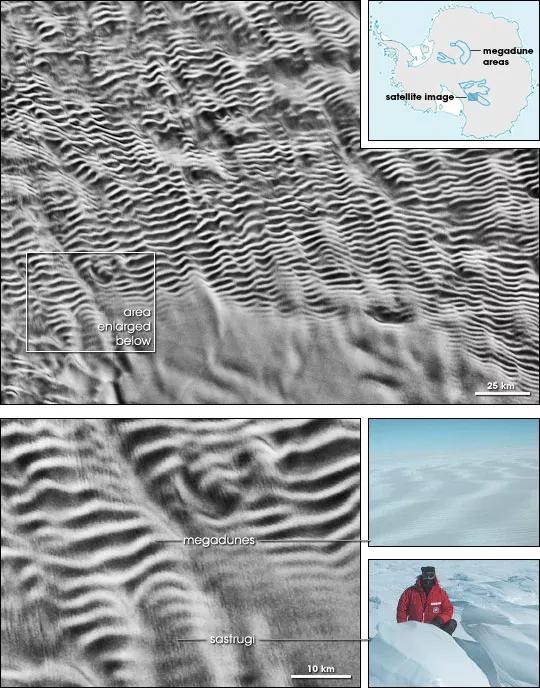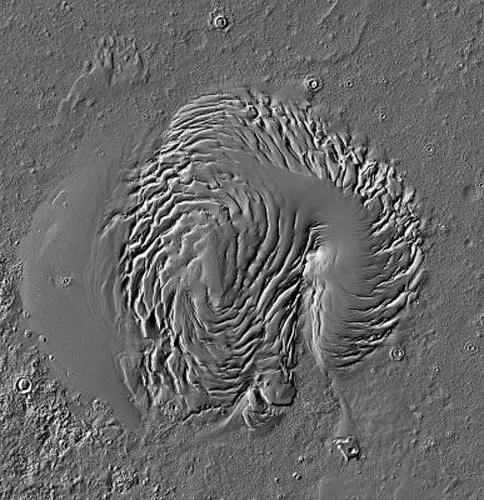By Laura Naranjo
The Red Planet, Mars, has long been a tempting destination for space explorers. Although Mars has much a colder climate and a thinner atmosphere than Earth, it features wind, weather, and clouds, along with rotational and seasonal cycles similar to Earth’s. Mars also harbors water, and abundant evidence of ancient streams and lakes, suggesting the possibility of life, or at least life that existed eons ago. But much of the water on Mars is now frozen in the planet’s polar ice caps, much like the ice sheet that covers Antarctica here on Earth. Satellites have returned polar images revealing giant dunes of snow and ice, similar to sand dunes, and strikingly similar to megadunes found on the Antarctic Plateau.
Antarctica’s dunes, which look like gentle but massive waves, measure approximately two to four meters high and range two to five kilometers from crest to crest. Understanding the dunes could be critical to unraveling the history of Mars, if future visitors arrive to drill into its ice cap—the same way researchers drill cores in Antarctic ice to reconstruct climate history on Earth. NSIDC senior research scientist Ted Scambos is among those who have visited and studied Antarctica’s megadunes. The insights he and his colleagues gleaned now provide a foundation for researchers studying megadunes on Mars.
Dunes of a different stripe
Whether made of sand or snow, most dunes accumulate when small grains are blown upwind, over an obstacle or crest, and then deposited as winds tumble down the leeward side. But Antarctica’s snow dunes form differently, sculpted by strong katabatic winds—cold gales that continuously sweep downhill from the continent’s highest icy ridges. In this environment, blowing snow is an almost constant feature. Whenever the wind drops in speed, even a little, the snow accumulates. This builds dunes that accumulate on the upwind side. Then, the extremely dry winds scour the downwind side, which sublimates, or vaporizes the snow and ice directly into the atmosphere.
In satellite radar data, Antarctic megadunes look like a giant fingerprint on the ice sheet, with broad ripples sinuously covering vast areas of the flank of the high-altitude ice sheet. Scambos and his colleagues visited Antarctica three times between 2002 and 2009 to take a closer look at these megadunes, digging pits, dragging instruments, and setting up weather stations.
Snow grains on the upwind face—where megadunes accumulate—tend to be young new snow, very tiny and acicular (needle-like) in shape, unlike the pretty six-sided flakes we are used to. The wind creates a very rough texture on the surface, and under the cold conditions, the landscape is like an ocean surface that suddenly froze solid on a blustery day. The downwind side is composed of older and larger ice grains polished smooth by katabatic winds, making the surface almost glassy. When observed from satellites, the rougher upwind surfaces reflect, or scatter, more light and appear bright. Smoother downwind surfaces absorb more energy and appear darker, creating the striped appearance. Various satellites also orbit the Red Planet, where researchers have discovered similar stripes in its polar ice.
Climate clues on the Martian pole
Scientist Claude Herny and his colleagues at Centre national de la recherche scientifique in France (CNRS) investigated the rippling stripes that spiral around the Martian North Polar Cap. To understand what they were seeing, scientists referred to the research Scambos and his colleagues conducted among Antarctica’s megadune fields. At first, the differences are striking: Martian megadunes are many times larger than those in Antarctica, spanning hundreds of kilometers in length, and stretching sixty kilometers from crest to crest. And researchers found not one, but two sets of dunes. On the upwind side of the larger dunes, smaller undulations have formed, although even they are up to five times larger than Antarctic megadunes, averaging about ten kilometers across.
Yet both sets of dunes share a similar texture and morphology with Antarctic megadunes, although the larger dunes have steeper downwind sides and more variation in their accumulation and deposition patterns. While the researchers do not know yet how or why the smaller dunes formed, they seem to be formed by processes similar to those that created the undulating Antarctic megadunes.
What do these similarities mean? The presence of snow megadunes, shaped by katabatic winds, implies that the Martian North Pole has a frigid and icy but dry climate much like the Antarctic Plateau. Martian megadunes hint at an intricate interaction between the icy cap and the planet’s atmosphere, providing a baseline for future research into Martian polar environments. Until travel to Mars becomes possible, research into our own planet continues to provide useful analogs. Knowledge of Earth’s icy regions will help us better understand the Martian poles and climate, preparing us for the moment when humans eventually set foot on the Red Planet.
References
Fahnestock, M. A., T. A. Scambos, C. A. Shuman, R. J. Athern, D. P. Winebrenner, and R. Kwok. 2000. Snow megadune fields on the East Antarctic Plateau: extreme atmosphere-ice interaction. Geophysical Research Letters 27(22): 3,719-3,722. doi:10.1029/1999/GL011248.
Herny, C., M. Massé, O. Bourgeois, S. Carpy, S. Le Mouélic, T. Appéré, I. B. Smith, A. Spiga, and S. Rodriguez. 2014. Sedimentation waves on the Martian North Polar Cap: Analogy with megadunes in Antarctica. Earth and Planetary Science Letters 403: 56-66. doi: 10:1016/j.epsl.2014.06.033.

